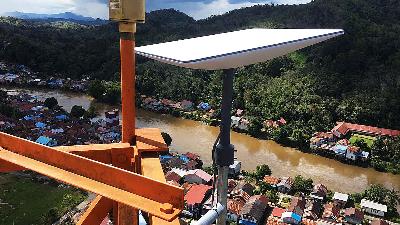The Price for Neglecting Disaster Mitigation
The impact of the disaster in West Sumatra is more serious because the regional government was busy chasing revenue.
Tempo
May 20, 2024

THE recent disaster in West Sumatra shows how the greed of the regional government has sacrificed the environment and cost people’s lives. The landslide and inundation of ‘cold lava’—volcanic materials carried by flash floods—resulting from the eruption of Mount Marapi has killed dozens of people and destroyed hundreds of buildings in Agam and Tanah Datar regencies since April. This damage should serve as a harsh warning for the government regarding the management of disaster-prone areas.
The Lembah Anai (Anai Valley) on the slopes of Mount Marapi has been designated as a protected forest area since the Dutch colonial era. The region is very hilly and there is almost no flat land. Because of the likelihood of landslides, all the rivers and forests on the slopes should be preserved to prevent more serious disasters. But it seems that this was not the view of the regional government.
Located right next to the Trans-Sumatra Highway, Lembah Anai has considerable potential to be developed into a tourism area. The waterfalls in the valley have long been known as a tourist spot. The problem is that in the last few years, many tourist facilities have been constructed, from hotels and restaurants to bathing places and residential areas. Moreover, some cafés and other buildings have even been constructed on land reclaimed from the river. It is no surprise then that when floodwaters came, dozens of buildings vanished overnight.
It seems that some of these tourism facilities were constructed without proper analysis of the environmental impact. Some do not even have building permits. Strangely, the regional government and the West Sumatra Natural Resources Conservation Agency appear to have closed their eyes to these violations.
It is strongly suspected that these violations were allowed to go unpunished because the regional government wanted additional revenue from the area that had previously only been a forest. But the eventual price paid as a result of the disaster far exceeded the money that flowed into the government’s coffers.
The central government must not just stand idly by. There must be a firm action to stop all regional policies that seek to bring in short term revenue without considering the environmental impact. Remember, almost all of Indonesia sits on the Pacific Ring of Fire. We live on a chain of volcanoes that could erupt at any time and trigger earthquakes. Because so many areas are prone to disaster, the government must consider disaster mitigation every time it issues a policy.
In essence, disaster mitigation is a way of preparing people to face dangers that have the potential to cause disasters. This requires the government to draw up policies that make people less vulnerable, including enforcing discipline in spatial and regional planning, and in disaster-prone areas.
Therefore, regions such as Lembah Anai must be subject to intensive oversight, not be exploited on a large scale. If the government continues to ignore the importance of mitigation measures, it is only a matter of time before we are swept away by the next disaster.



